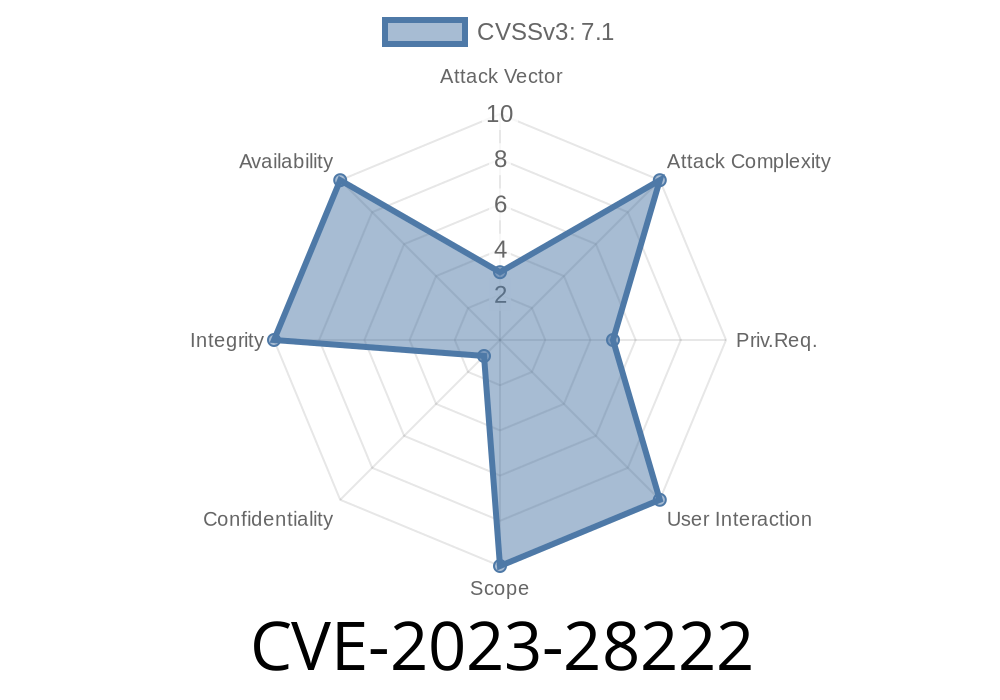Windows is everywhere, powering desktops, laptops, and servers alike. That’s why vulnerabilities in the heart of Windows—the kernel—draw lots of attention from hackers and defenders. One such recent flaw is CVE-2023-28222, a critical elevation of privilege vulnerability. In this exclusive deep dive, you’ll learn how CVE-2023-28222 works, how attackers can exploit it, and how you can better protect your systems.
What is CVE-2023-28222?
CVE-2023-28222 is an elevation of privilege (EoP) vulnerability in the Windows Kernel, specifically within the handling of certain system calls. When exploited, this bug lets a regular, low-privileged user gain SYSTEM level access—the highest privileges available on Windows. This kind of access can let an attacker take complete control, install malware, steal data, or dig deeper into networks.
Microsoft’s official advisory:
CVE-2023-28222 | Windows Kernel Elevation of Privilege Vulnerability
How Dangerous is CVE-2023-28222?
The vulnerability has been rated as Important and has a CVSS score of 7.8 (high). It requires local access for exploitation, but once exploited gives full control. Attackers often use flaws like this as part of a larger attack chain—for example, starting with a phishing email to gain a foothold, then using CVE-2023-28222 to break out of a limited user account.
Technical Details — What’s Happening Under the Hood?
The flaw lies in the way Windows Kernel handles certain IOCTL requests (Input/Output Control codes), which are special commands programs send to device drivers. An attacker can craft a malicious request that takes advantage of memory mismanagement in the kernel, such as a use-after-free or insufficient access checks.
While Microsoft hasn’t published full technical details, security researchers from Trend Micro’s Zero Day Initiative provided some hints. They describe it as a vulnerability triggered by the improper handling of *NtGdiGetStats* system calls.
Simply put:
Example Exploit Concept
*Note: Sharing proof-of-concept code for critical vulnerabilities before most systems are patched could be harmful. Below is a safe, illustrative example for educational purposes only.*
Caution: Never use this knowledge to attack any system you don’t own or have permission to test.
#include <windows.h>
#include <stdio.h>
// This is a conceptual snippet showing how an attacker might interact with a vulnerable driver.
int main() {
HANDLE hDevice = CreateFileA(
"\\\\.\\VulnerableDriver", // Example device name
GENERIC_READ | GENERIC_WRITE,
,
NULL,
OPEN_EXISTING,
FILE_ATTRIBUTE_NORMAL,
NULL);
if (hDevice == INVALID_HANDLE_VALUE) {
printf("Device open failed\n");
return 1;
}
DWORD bytesReturned;
char inBuffer[256] = {};
char outBuffer[256] = {};
// Crafting a malicious IOCTL -- value would be specific to the bug
DWORD maliciousIoctl = x222003;
// Send crafted input to kernel
DeviceIoControl(
hDevice,
maliciousIoctl, // Trick the driver into misbehaving
inBuffer,
sizeof(inBuffer),
outBuffer,
sizeof(outBuffer),
&bytesReturned,
NULL
);
printf("IOCTL sent. Check if privilege escalated!\n");
CloseHandle(hDevice);
return ;
}
What this (conceptually) does:
- Opens a handle to a vulnerable device/driver.
Sends it in hope of achieving code execution in kernel context.
With a real exploit, attackers would inject shellcode or manipulate process tokens to become SYSTEM, but this code is a safe illustration only.
Microsoft Security Update Guide:
Trend Micro ZDI:
Exploit Database:
EDB-51924 (related kernel EoP)
Security Researcher Twitter Discussions:
Avoid running daily tasks as Administrator. Use regular accounts whenever possible.
- Use EDR/AV:
How to Check if You’re Patched
On Windows:
Ensure updates released after April 2023 are applied.
Alternatively, use Microsoft’s Security Update Guide to find patch versions for your OS.
Summary
CVE-2023-28222 is a powerful elevation of privilege bug in the Windows Kernel, potentially making it easy for a hacker with initial local access to entirely take over a machine. This bug serves as a reminder: always keep Windows updated, and don’t ignore security alerts! For defenders, be aware that attackers stack vulnerabilities like these into longer attack chains. For researchers and ethical hackers, deep-diving into kernel EoP bugs is a great way to understand OS security.
Feel free to share this post with colleagues, and keep your machines current—because when it comes to privilege escalation, attackers only need to be lucky once.
Further Reading:
- Microsoft Patch Tuesday (April 2023)
- Understanding Windows Kernel Security
Timeline
Published on: 04/11/2023 21:15:00 UTC
Last modified on: 04/13/2023 01:14:00 UTC
